
I bet you have noticed a star twinkling in the night sky—stars can shimmer because of Earth’s atmosphere or air. The turbulent air surrounding our planet affects the starlight, making it look like the star is sparkling! But did you know that even if we traveled outside our atmosphere, and paid close attention to the stars, we could still see many of them change brightness?
Many of the stars we see get brighter and even fainter over various periods of time. Some stars dim, brighten, dim again, and so on…in less than a second! Other stars take years to vary their brightness—and not because the star is dying. These stars are called “variable stars.”
Explore below to see a variable star that YOU can see every month! Many of these stars can be seen from all around the globe, but most are best viewed from the Northern Hemisphere.
All featured variable star content on this page is the result of a group effort between the AAVSO, Ball State University, and the International Planetarium Society, with the goal of bringing more astronomy into your home, and guiding you into making your first scientific observations!
January: Pleione in the Pleiades

One variable star YOU can see this month is Pleione, a member of a bright star cluster in the constellation Taurus, "The Bull." This cluster, called the Pleiades, looks like a small spoon or a very tiny dipper in the sky.
You can find Pleione as the dimmer of two stars in the "handle" of the spoon. Check Pleione from night to night and compare it to other stars in the cluster, especially the stars Taygeta and Celaeno at the opposite end of the spoon. You may have to look closely over a few nights, but you should see it change brightness. Binoculars make it a lot easier to observe Pleione and all the other stars in the Pleiades.
Why does Pleione change brightness like this? Pleione rotates once in just under 12 hours, so fast that some of the star is forced outward, forming a sort of disk shape around the star. Interactions between the star and the disk can cause minor changes in the star’s brightness. With a little practice, you can likely detect these changes from Earth!
To help you explore Pleione and the rest of the night sky, try using our special star comparison/finder chart below, our observation guide complete with tips on determining this star's brightness from night to night, or app on your phone!
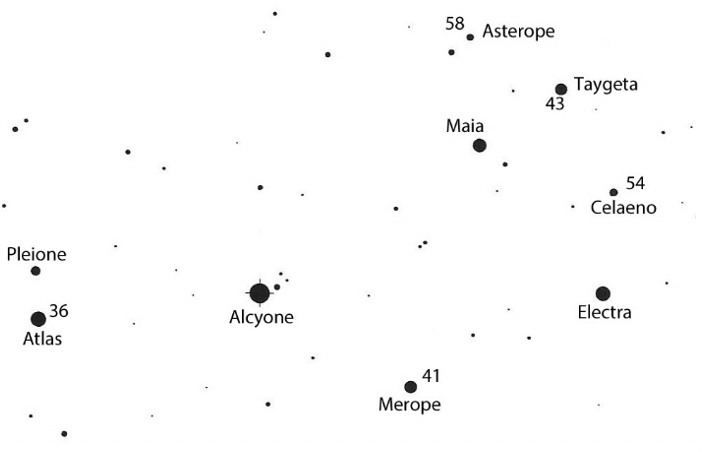
February: Betelgeuse (Alpha Orionis)

One variable star YOU can see this month is Betelgeuse, normally the brightest star in the constellation of Orion, "The Hunter." It is easily seen in the eastern shoulder of The Hunter, even from within a city.
Betelgeuse is amongst a class of stars known as “red supergiants.” As its name implies, Betelgeuse is so large that, if it were placed at the location of our Sun, its outer atmosphere would extend out beyond Jupiter! It is a relatively nearby star, roughly 420 light years away. A “light year” is the distance that light travels in one year—almost six trillion miles!
Betelgeuse may one day explode as a supernova, but it is far enough away that it will not present a hazard to Earth. However, the explosion will be bright enough that we will see it in the daytime and astronomers will have an opportunity to easily study the explosion.
While awaiting the possible supernova explosion, we can watch Betelgeuse pulsate on an 11-month timescale, first determined in1836 by John Herschel—son of the astronomer William Herschel, who discovered Uranus. As it pulsates, it can change in brightness, becoming three times brighter!
You can compare it to Rigel, also known as Beta Orionis, which is diagonally opposite Betelgeuse in Orion; Bellatrix, a.k.a. Gamma Orionis (in Orion’s other shoulder); or Aldebaran, the bright eye of Taurus the Bull. In late 2019 and early 2020, Betelgeuse dipped to the brightness of Bellatrix, its faintest on record. With a little practice, you should be able to detect these changes, even from all the way here on Earth.
To help you explore Betelgeuse, Orion, and the rest of the night sky, try using our special star comparison/finder chart below and observation guide, or an app on your phone.
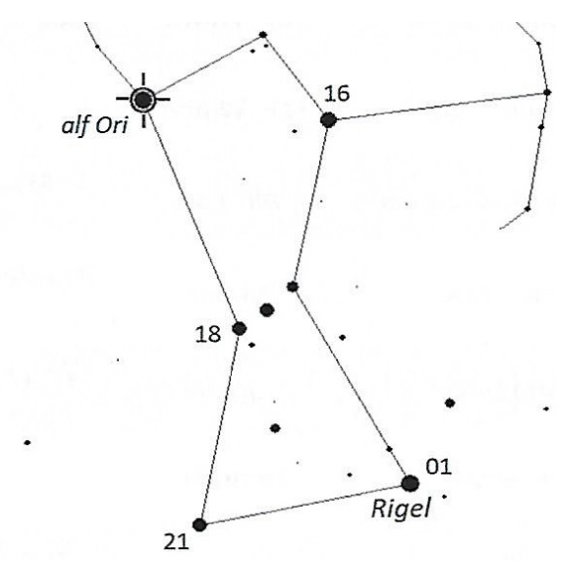
March: Propus (Eta Geminorum)
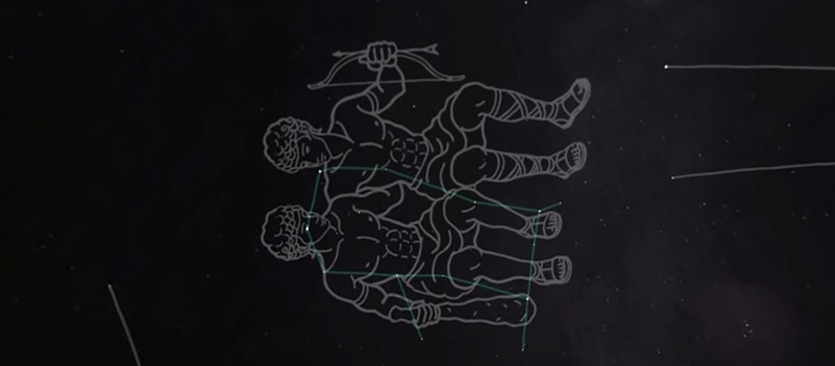
One variable star YOU can see this month is Propus, also known as Eta Geminorum. It’s in the constellation of Gemini, "The Twins." Gemini is a rectangular shape in the stars that represent the twins Castor and Pollux from Greek mythology. In fact, the top two stars of the rectangle are named Castor (the western star) and Pollux (the eastern star). These stars mark the heads of the twins. Since Propus is Greek for “foot,” it makes sense that this star is found at the bottom of the rectangle, at the end of the leg of Castor, about midway between Mu Geminorum and a bright cluster of stars.
A U.S. Navy cargo ship, USS Propus, was named after the star. German astronomer and geophysicist, Julius Schmidt, first recorded Propus as a variable star in 1865. You can conveniently compare it to the nearby star Mu Geminorum. Propus slowly changes its brightness by 50% over 234 days.
Besides its variability, Propus has another claim to fame. It lies within one degree of the ecliptic (the apparent path the Sun makes in the sky throughout the year). This is also the part of the sky where you can find the Moon, and many other solar system objects that are much closer to us than the distant stars. The ecliptic draws its name as being in the part of the sky where eclipses of the Sun and Moon occur. Occasionally, the Moon will occult (pass in front of) Propus. Rarely, one of our solar system planets may occult the star. The last time this happened was in 1910, when Venus made its way in front of the star.
Propus is a red giant star—which you can guess means that it is a really large, red star. In 1881, a famous observer of double stars, S.W. Burnham, discovered that it had a dimmer, yellow companion in orbit around it. Today, we know that there are three stars in orbit around each other there, meaning it is a triple star system. Its even closer companion may eclipse the brighter, main star every eight years. With a little practice, you could likely detect these changes in brightness, even from all the way here on Earth!
To help you explore Propus, Gemini, and the rest of the night sky, try using our Propus star comparison/finder chart below and observation guide, or an app on your phone.

April: R Leonis

One variable star that YOU can see this month is R Leonis, the first variable star to be identified in the constellation Leo the Lion. When discovered by J.A. Koch of Danzig in 1782, it was only the fourth long period variable known. Make your own discovery of this star by looking 5 degrees (about one binocular field) west of the bright star Regulus (Alpha Leonis), the heart of this lion constellation. Here, you’ll see R Leonis as a scarlet- colored star, forming a small triangle with two nearby yellow stars.
R Leonis is a red giant star near the end of its life that has a radius about the size of Mars’s orbit. Its brightness changes by a factor of 250 over a period of about 310 days.
At its dimmest, it may even be difficult to see in binoculars: then, just “look for the star that isn’t there!” That is to say, look for the star that is “missing” from the typical star pattern. Of course the star is still there, we just can’t see it!
Because of low surface gravity, the outer atmosphere of R Leonis is loosely bound, forming a shell around the stellar core. It is believed that pulsations within the star’s core send shock waves through this shell, causing the star to vary in brightness. A similar fate may await our Sun--but not for another 5 billion years or so.
To help you explore R Leonis, the constellation Leo, and the rest of the night sky, try using our R Leonis star comparison/finder chart below, and observation guide, or an app on your phone.

May: V Hydrae

One variable star that YOU can see this month is V Hydrae in the constellation of Hydra the Sea Serpent. Though often bright enough to be seen with your naked eye from a dark sky site, it is easily spotted in binoculars. You’ll be able to notice it by its deep cherry red color--about 5 degrees south of a bright star, Nu Hydrae.
V Hydrae was known for its stunning red color even before S.C. Chandler of Harvard University announced its variability in 1888. Why is this star so amazingly red? The relatively cool red giant V Hydrae is a member of a rare class of stars known as “Carbon Stars” because of the relatively high concentration of carbon in the star’s atmosphere. This excess of carbon is the reason for its deep red color.
As a semi-regular variable, it pulsates, with its brightness changing by a factor of 11 over a period of about 530 days. This period is superimposed on a longer period of 18 years where the brightness may drop even further, probably due to a surrounding disc of material obscuring the star’s light.
Though not visible to our eyes, astronomers have observed high-speed material jets flowing out of the star. Dubbed “bullets,” these ejections occur every 8.5 years and are thought to be caused by the close approach of a dim companion star.
To help you explore V Hydrae, the constellation Hydra, and the rest of the night sky, try using our V Hydrae star comparison/finder chart below, and observation guide, or an app on your phone.

June: Y Canum Venaticorum (La Superba)
One variable star that YOU can see this month is Y Canum Venaticorum in the constellation Canes Venatici, the Hunting Dogs. Nicknamed “La Superba”(meaning “the magnificent”) by the Jesuit astronomer Father Angelo Secchi in 1867 because of its deep red color, the International Astronomical Union formally accepted the name in 2016.
It is located about a third of the way from Chara (Beta Canum Venaticorum) toward the famous pair Alcor and Mizar in the handle of the Big Dipper. In dark skies, La Superba is just barely visible to the naked eye, but its red color makes it obvious in binoculars.
La Superba is one of the reddest stars known. It is a semi-regular variable star whose brightness drops by 75% over a period of every 157 days. It is the brightest of the giant red carbon stars (stars that have a relatively high concentration of carbon in their atmosphere). It is also an example of an exceedingly rare category of carbon stars that contain a large amount of the isotope carbon-13, which has an extra neutron, rather than the more common isotope carbon-12.
It is such a large star that if it replaced the Sun in our solar system, its outer atmosphere would extend beyond Mars.
To help you explore Y Canum Venaticorum, the constellation Canes Venatici, and the rest of the night sky, try using our Y Canum Venaticorum star comparison/finder chart (below) and observation guide, or an app on your phone.

July: R Scuti

One variable star that YOU can see this month is R Scuti in the constellation Scutum the Shield. When the English observer E. Piggot discovered it in 1795, it was one of only a few variable stars known. At its brightest, it is an easy star to see. Even at its dimmest, some 50 times dimmer, you can still see it in binoculars. It is easy to find since it lies just a degree (about 2 diameters of the full Moon) northwest of a cluster of stars called the “Wild Duck Cluster,” so named because the bright stars in the cluster form a “V” - like a flock of flying ducks.
R Scuti is the brightest of a class of variable stars called RV Tauri stars, after the prototype, or first star, to be determined of the class. Such stars are a small group of yellow supergiant stars that are thought to be near the end of their life. They may provide us with information about the evolution of stars as they transition to white dwarfs.
Visually, they are characterized by alternating patterns of deep and shallow minima--periods of minimum brightnesses. R Scuti has a period of about 144 days between deep minima. For example, every fourth or fifth minimum is exceptionally faint for reasons that are not well understood. The star seems to be pulsating in at least two superimposed periods, possibly due to shock waves within the star itself or their interaction with a surrounding cloud of gas and dust.
To help you explore R Scuti, the “Wild Duck Cluster,” the constellation Scutum, and the rest of the night sky, try using the R Scuti star comparison/finder charts below, our observation guide, or an app on your phone.
|
Credit for above (left) image: AAVSO Variable Star Plotter, with constellation lines and R Scuti locator input by Jim Fox. |
Credit for above (right) image: Torsten Brongerderivative work: Kxx (talk) - Scutum_constellation_map.png, CC BY-SA 3.0, https://commons.wikimedia.org/w/index.php?curid=10886497 |
August: R Aquilae and the Summer Triangle
This month, you can view the "Summer Triangle." Below, tips to view three stars, of three different constellations, that form the triangle: R Aquilae, Beta Lyrae, and Chi Cygni. To get a good idea of the positioning of these stars as seen from Earth, and how to find them, click on the August videos in the panel to the right.
Variable star R Aquilae: located just off the trailing edge of the western wing of Aquila the Eagle, it is about 5 degrees due south of Zeta Aquilae, which marks the wing tip. R Aquilae is a red giant star. It has about the same mass as our Sun, but it has expanded as it aged. If it were located at the place of our Sun, Earth would be orbiting just inside its outer atmosphere!
At its brightest, R Aquilae is visible to the naked eye as a dim, red star. When it dims over 600 times from its brightest, it would be just visible in binoculars. Its period from one dimming to the next is about 270 days. Oddly, this period has been decreasing at an average rate of about 9 hours per year since first determined in 1915. The reason for this decrease is not understood at this time.
Variable star Beta Lyrae (Sheliak): another point of the summer triangle YOU can see tonight is Beta Lyrae (also called Sheliak, a name in Islamic astronomy) for the constellation Lyra, the Harp. The constellation Lyra is easily seen, even from within light-polluted urban skies. Sheliak lies at the southwest corner of the parallelogram of bright stars that make up the constellation Lyra. The variation can be followed by comparing Sheliak to Gamma Lyrae, lying nearby across the southern edge of the parallelogram. Sheliak dims by almost two-thirds over a period of just under 13 days.
The star’s variability was noted in 1784 by John Goodricke. He speculated that the variation was due to either eclipses or a rotating star with “star spots.” Today, we know that it is an example of eclipsing binary, where two stars orbit each other in such a way that, as seen from Earth, However, the light change is continuous over the course of its period and not the rather abrupt light change of other eclipsing binaries such as Algol. This suggests that Sheliak is a member of an even rarer classification called “semi-detached binaries.” One of the stars is so massive that its gravity is pulling material away from the other!
Chi Cygni is in Cygnus the Swan nearby!
To help you explore R Aquilae, Sheliak, Chi Cygni, their constellations, and the rest of the night sky, use the star comparison/finder charts below, and our observation guide. You can also try using an app on your phone.
Below, R Aquilae is marked by the ![]() icon
icon

Credit for above image: AAVSO Variable Star Plotter, with constellation lines and R Aquilae locator input by Jim Fox.
Below, Chi Cygni is circled in red, and Beta Lyrae is marked by the Beta symbol, ![]() (in the Lyra constellation, below Vega).
(in the Lyra constellation, below Vega).

Credit for above image: Torsten Bronger derivative work: Kxx (talk) - Cygnus_constellation_map.png
September: Delta Cephei
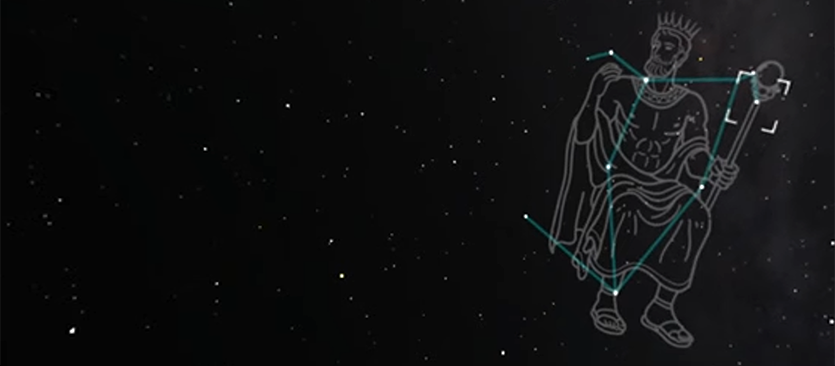
One variable star YOU can see this month is Delta Cephei, normally the fourth brightest star in the constellation Cepheus, The King, near the southeast corner of “the box.” Delta Cephei is the prototype of a whole class of variable stars known as “Cepheids.”
Astronomer John Goodricke first noted the Variability of Delta Cephei in 1784. In 1912, Henrietta Swan Leavitt studied Cepheid variables at Harvard College Observatory. These stars vary in brightness with a regular period, and Leavitt discovered that the period of variation of individual Cepheids is related to the true brightness of the star.
This property allows scientists a way to determine the distance to stars. That is, the more luminous a Cepheid variable is, the longer its pulsation period. After we know a star’s true brightness, we can determine the distance to the star, or for stars outside the Milky Way Galaxy, the approximate distance to the galaxy that the star is inside.
By measuring the periods and brightnesses of a dozen Cepheid variables in the then-called “Andromeda Nebula,” Edwin Hubble determined that it was over 900,000 light years distant in 1924. (A “light year” is a distance measure used by astronomers, and is the distance light will travel in one year: almost 6 trillion miles!) Thus, the so-called “nebula” was another galaxy outside our own Milky Way. Cepheid variables have become one of several “standard candles” allowing us to determine vast distances in the universe.
Delta Cephei is much closer, being only 865 light years from us and within our own galaxy. Its period of variation is about once every five and a half days. You can watch it go through its cyclic dimming and brightening by comparing it to the nearby stars Zeta Cephei and Epsilon Cephei.
To help you explore Delta Cephei, the constellation Cepheus, and the rest of the night sky, use the star comparison/finder chart below and observation guide. You can also try using an app on your phone.

October: Mira (Omicron Ceti)
One variable star YOU can see this month is Mira, or Omicron Ceti, in the constellation Cetus the Whale, or Sea Monster. You can find it by imagining the “V” of stars in Pisces (with Alpha Piscium at its tip) as being an arrowhead pointing south to Mira. Another “V” of stars is formed by the Hyades cluster in the face of Taurus, the Bull, pointing to the west. Where the two pointing lines intersect, you will find the variable star....
Or maybe not! At its brightest, Mira is easily visible to the naked eye. But at its faintest, seeing it may be a challenge, even through binoculars. Perhaps that is why Johannes Hevelius coined the name Mira (Latin for “wonderful” or “astonishing”) in 1662.
David Fabricus thought it might be a nova when he saw it first brighten and then fade in 1596, but then he saw it brighten again in 1609. Today, we know the star’s period is about 332 days, and it spends about half its time fainter than naked eye visibility.
Miras are a class of variable stars that have completed fusing their hydrogen fuel, and are the coolest, largest, and most luminous red giant stars. Their brightness varies as the star pulsates. Recent Hubble Space Telescope images of Mira show evidence of mass streaming away from the star at a rate of one Earth mass per year.
To help you explore Mira, the constellation Cetus, and the rest of the night sky, use the star comparison/finder charts below, and our observation guide. You can also try using an app on your phone.
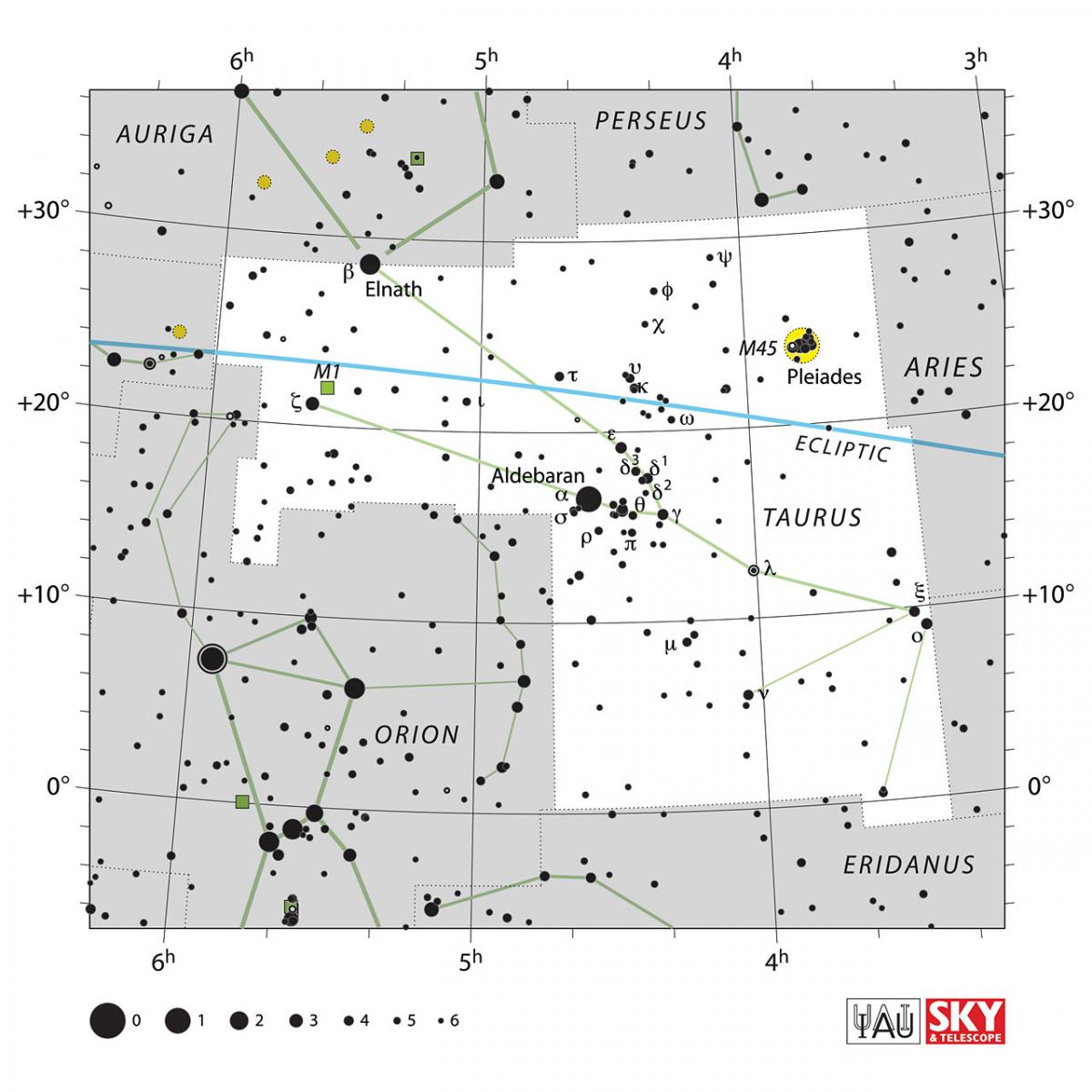
(https://www.iau.org/public/images/detail/tau/)
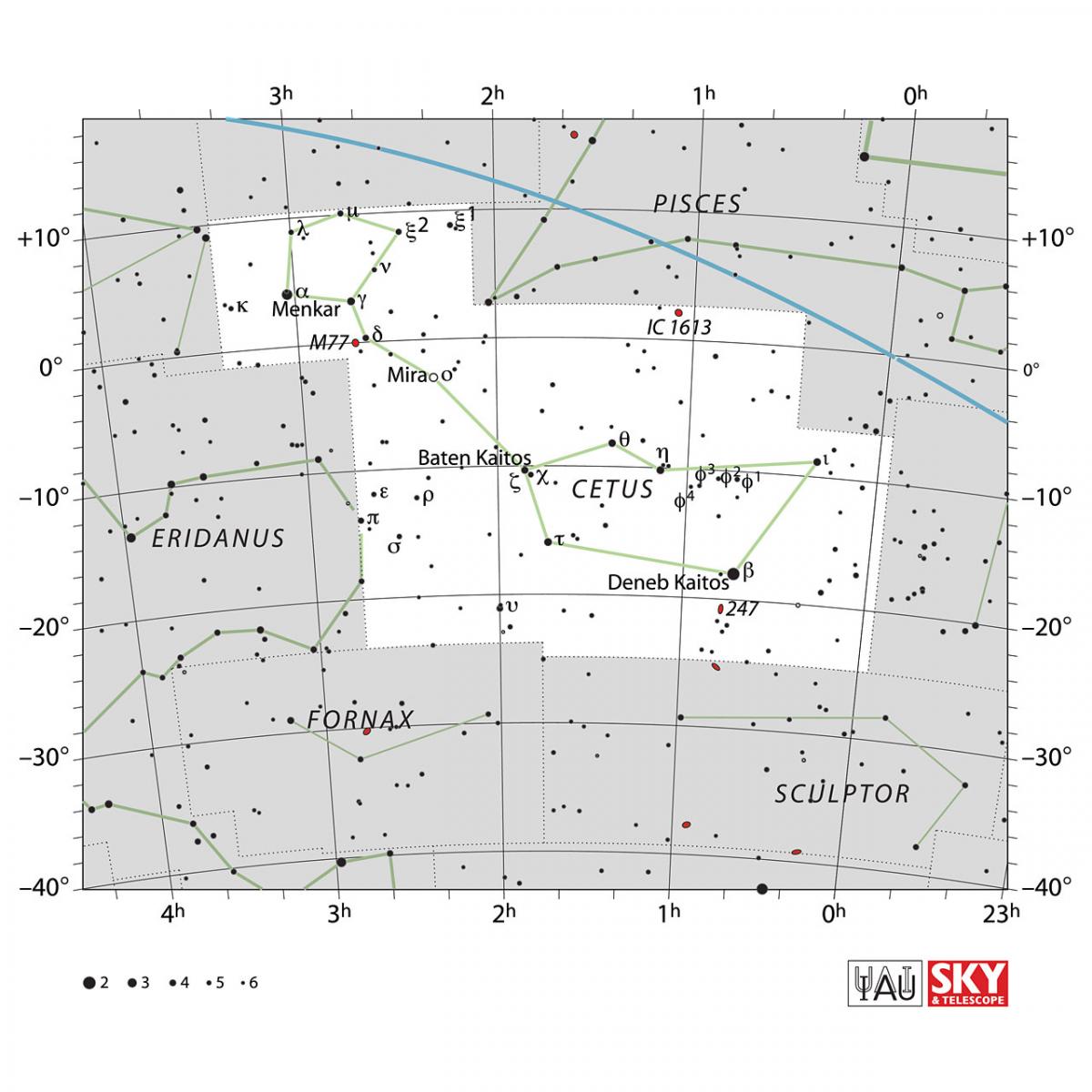
(https://www.iau.org/public/images/detail/cet/)
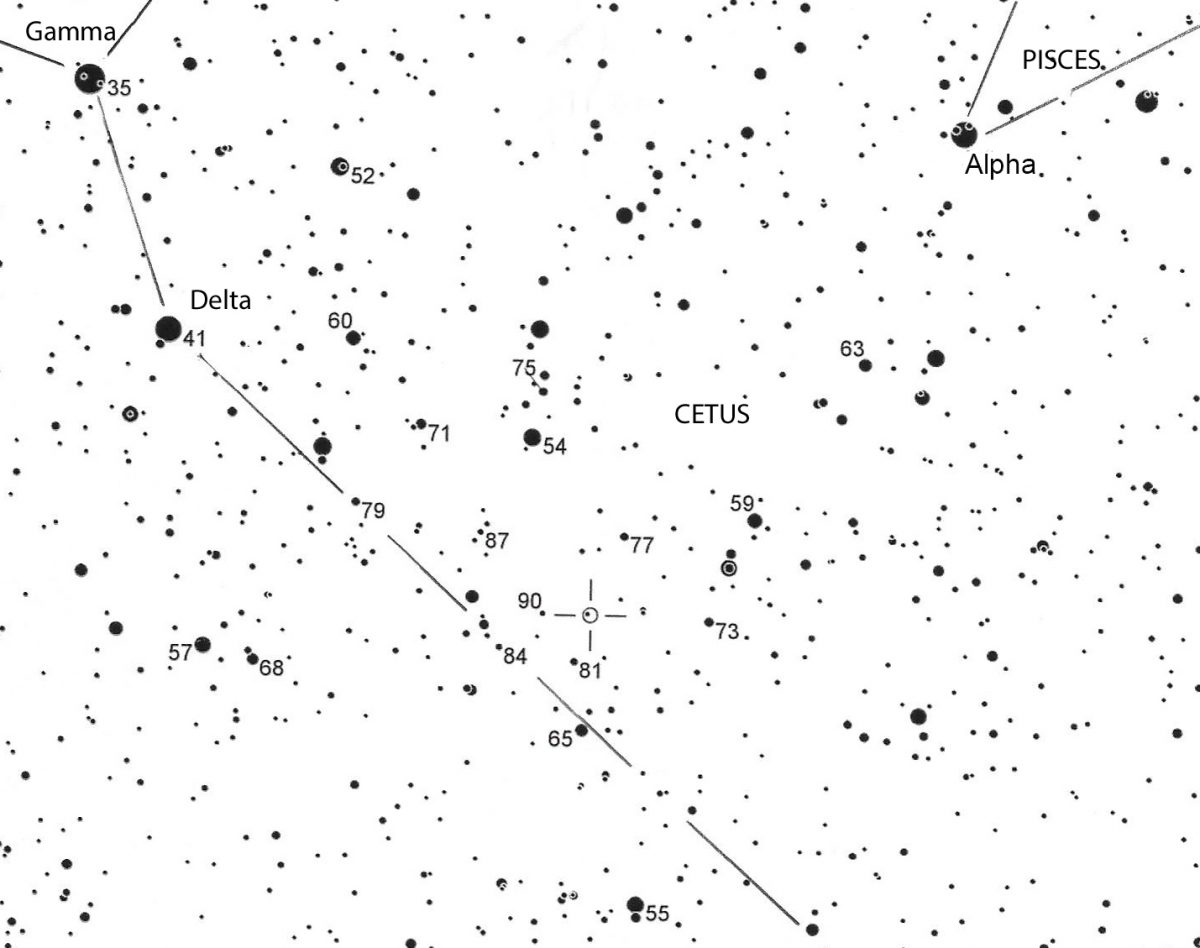
November: Epsilon Aurigae (Almaaz)

One variable star that YOU can see tonight is Epsilon Aurigae, also recognized by the name Almaaz, the Billy Goat. It is located just west of the pentagon that forms the constellation Auriga, the Charioteer, and about three degrees southwest of the bright star Capella, the Latin word for “Nanny Goat.” Two dimmer stars, just south of Almaaz, are often referred to as “the Kids” in keeping with the goat theme of names.
Every 27 years, Epsilon Aurigae stays dim for almost two years. This is an example of an “eclipsing binary,” where a bright star is covered periodically by a dimmer object passing in front of it. But what is this dimmer object eclipsing Epsilon Aurigae?
This question puzzled astronomers for years, but they mounted an extra effort during the eclipse of 2009 to 2011. Collaborations between professional and amateur astronomers collected enormous amounts of data, and now they have a good idea of this mysterious body. The mystery object is another star in orbit, and is embedded in an immense gas cloud and can not be seen in visual light. The hidden star is a massive object that probably accumulated its gas and dust cloud by capturing parts of the outer atmosphere and “stellar wind” of the visible star. Small brightness variations during the two-year eclipse may be due to variations in the opacity or concentration of material in the cloud.
To help you explore Epsilon Aurigae, the constellation Auriga, and the rest of the night sky, try using the star chart below, our observation guide, or app on your phone.

December: Algol ("The Demon Star”)
One variable star YOU can see tonight is Algol, or Beta Persei. Known to Arab astronomers in antiquity, they gave it the name “al Goul,” meaning “the Demon” or “the Evil One,” since it seemed to wink at them from time to time. The English astronomer John Goodricke is credited with determining that Algol has a definite dimming and brightening period.
In 1881, an American astronomer, Edward Pickering, presented convincing evidence that Algol is really two stars, even though they just look like one star to us. In this star system, one star is brighter than the other. Like clockwork, the dimmer star passes in front of (eclipses) the brighter star. When it does, it causes them to appear much dimmer than usual. We can actually see this change with our eyes. Stars like these are called “eclipsing variables.”
The two stars are separated by 57 million miles, about the same distance Venus lies from our Sun. But where Venus takes 225 days to orbit the Sun, the stars of the Algol system complete their orbit in about 69 hours. The duration of the eclipse lasts about eight hours. That means you can watch the entire eclipse within a single night, if you look at the right time!
On most nights, you will be able to see Algol either get brighter or dimmer, but you won't see the full eclipse. Since the dimming or brightening takes only 4 hours, you should check the brightness of Algol every 20 to 30 minutes to follow the change. Alpha Persei and Delta Persei are located nearby: use them for comparison because they don’t change in brightness like Algol does.
To help you explore Algol and the rest of the night sky, try using our special star comparison/finder chart below, our observation guide complete with tips on determining this star's brightness from night to night, or app on your phone! Predicted times for minimum light may be found on your phone app, or you can simply watch it on a clear night.

Scroll to see 11 other featured variables and how to observe them from the northern hemisphere in 2022!






